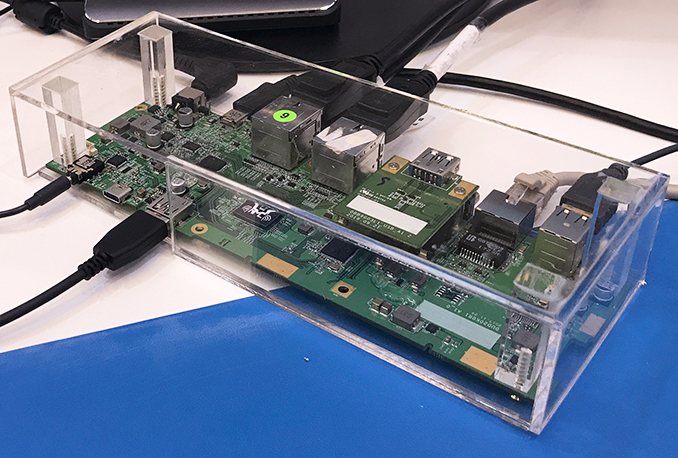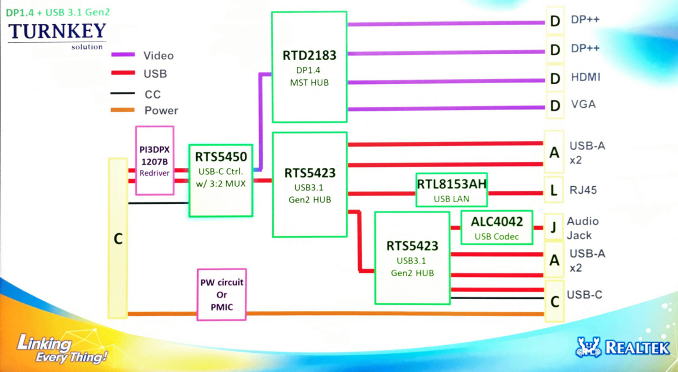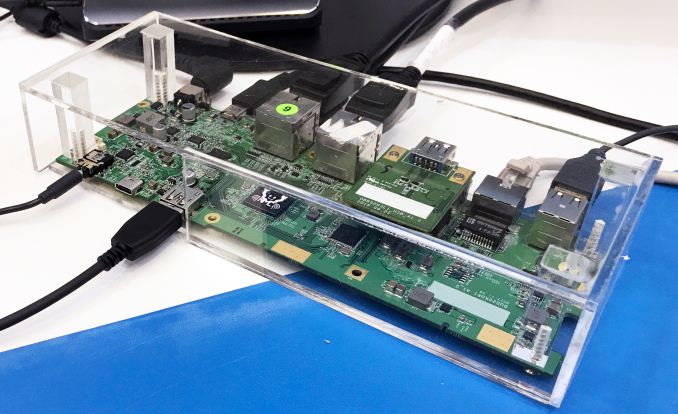Realtek Demonstrates a USB 3.1 G2 Type-C Dock Platform: An All-in-One Solution
by Anton Shilov on June 18, 2018 2:00 PM EST- Posted in
- Peripherals
- Trade Shows
- Realtek
- USB-C
- USB-C Hub
- Computex 2018

Realtek demonstrated a prototype of a USB 3.1 Gen 2 docking station that relies entirely on its own chips and features regular connectors, including USB Type-A, DisplayPort, HDMI, D-Sub, GbE, and audio.
USB Type-C is gaining popularity rather rapidly among notebook makers and there are a number of non-Apple laptops that feature only these connectors. Meanwhile, such laptops need docking stations to gain compatibility with regular USB Type-A, Gigabit Ethernet, display outputs and so on. Such devices are available, but are not always cheap because makers of hubs have to develop these products themselves and use chips from various suppliers. By contrast, Realtek’s turnkey USB 3.1 Gen 2 hub is based on chips that come exclusively from the company and the whole design is production ready, meaning no R&D investments from actual manufacturers.
Realtek’s turnkey USB 3.1 Gen 2 (10 Gb/s) hub relies on the firm’s RTS5423, RTS5450, RTD2183, RTL8153AH, ALC4042, and the PI3DPX 1207B chips. The hub features four USB Type-A connectors, a USB Type-C header, two DisplayPort 1.4 outputs, an HDMI, a D-Sub, an 3.5-mm TRRS audio jack, and a GbE port.
Realtek naturally does not indicate pricing of actual solutions based on its reference design because they depend on materials used and actual configuration of connectors. Today sophisticated USB-C docking solutions start at €109/$127, so hopefully Realtek’s turnkey dock will enable makers to bring the price of such products a bit down.
| Want to keep up to date with all of our Computex 2018 Coverage? | ||||||
 Laptops |
 Hardware |
 Chips |
||||
| Follow AnandTech's breaking news here! | ||||||












23 Comments
View All Comments
DanNeely - Monday, June 18, 2018 - link
Part of that block diagram has me shaking my head. The downstream USB-C port, the one most likely to have another high speed device attached, is one of the ports that's connected to a hub on a hub for maximum data contention.jordanclock - Monday, June 18, 2018 - link
Or it could just be slightly lower than direct connection. I can't find many reviews of products using the RTS5423 but from what little I can find, it still manages close to 1GB/s speeds.Alexvrb - Monday, June 18, 2018 - link
Right but there's two of em. Why isn't the hub-side Type C connected to the first one, like he asked? The first one has two USB-A's (3.1?), GbE LAN, and connects to the second RTS5423, which is further subdivided into audio, two more USB-A's, and the USB-C. Just a bit of a strange setup.eduardor2k - Tuesday, June 19, 2018 - link
It seems that each hub only supports 4 connections, that's why they need two of themwolrah - Tuesday, June 19, 2018 - link
Right, but the question is why is the C port, the most likely one to use high bandwidth, hung off of the daisy chained hub rather than putting it on the first hub. Why not move one more of the A connections to the first hub so the C port can be higher up the chain?wolrah - Tuesday, June 19, 2018 - link
Correction: "move one more of the A connections to the second hub"Valantar - Friday, June 22, 2018 - link
I'd expect this to be the exact reason for placing the type-C on the end of the chain, so to speak: to avoid it hoarding bandwidth and thus starving other critical ports such as Ethernet. Besides, isn't the main point of a type-C hub to connect devices that aren't type C? How many non-portable type-C devices are there out there that require massive bandwidth and aren't TB3? And if it's portable, it makes more sense to connect it directly to the laptop than keep it connected to a dock, after all. It stands to reason that type-C is the least important port on such a dock for the foresebeale future.Daniel Egger - Tuesday, July 3, 2018 - link
> Besides, isn't the main point of a type-C hub to connect devices that aren't type C?Problem is: Many devices are USB-C port starved, by connecting a dock in this weird configuration you're basically completely giving up on USB-C speeds. Even if you you don't use the the bandwidth the USB-C device will still be suffering...
But I guess the point of this USB-C port is an entirely different one: to allow for USB PD...
HStewart - Monday, June 18, 2018 - link
For me USB-C are interesting, especially having different USB-C laptops1. Power Delivery varies and need option to turn off - if power delivery is not enough to power laptop
2. Compatibility between multiple laptops varies in the docks I found. Usually it best to go with maker of the laptop - but hopefully that changes
3. USB-C G2 is not as powerful as Thunderbolt 3 and not sure if it can handle daisy chain of USB-C devices like Thunderbolt 3
Well the typical cost is $100, I serious doubt it going that much difference. Especially if compatibility is there.
DanNeely - Monday, June 18, 2018 - link
You can daisy chain USB hubs IIRC 7 layers deep. The potential gotcha is that not all the hubs in a chain are visible, eg some of the ports in this box are 2 chains deep not 1, sometimes a PC will have an onboard hub to get more ports. The latter was particularly common a few years ago when chipsets only had a handful of native ports a a 4 port hub was cheaper than a pair of 2 port controllers (in addition to the hub not eating PCIe lanes like the controller). Some devices will have a hub built in even though you wouldn't expect it, eg printers with card readers.